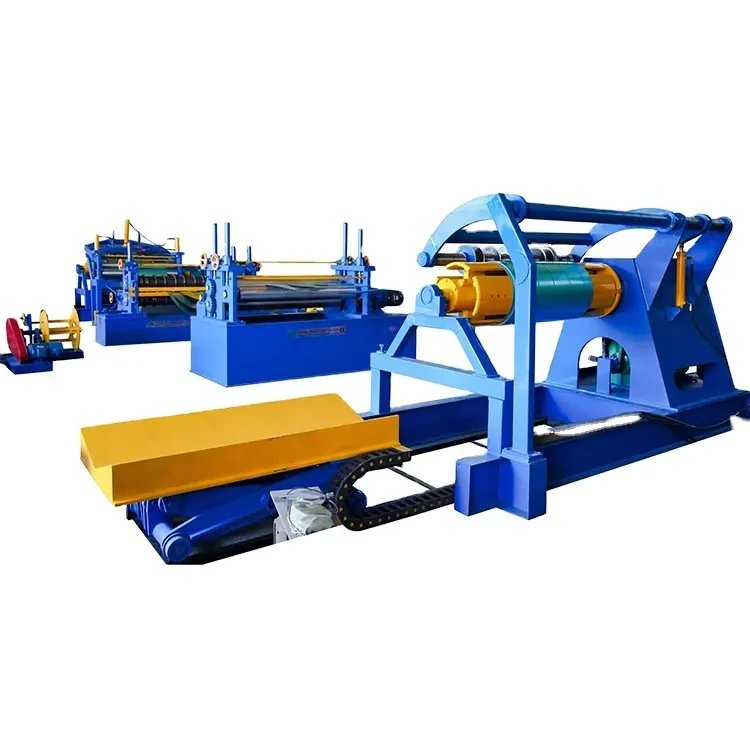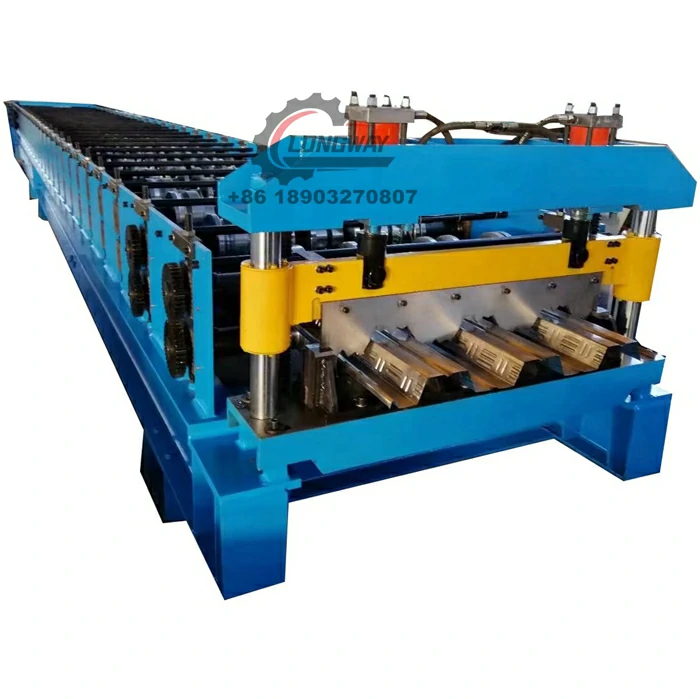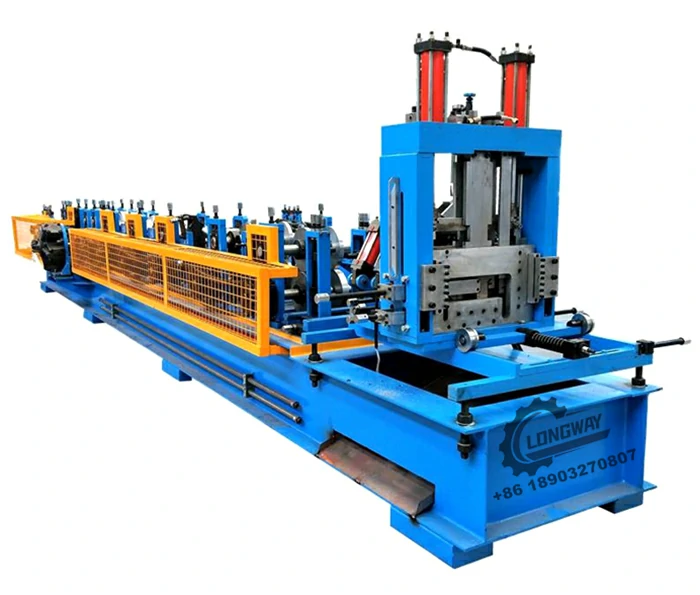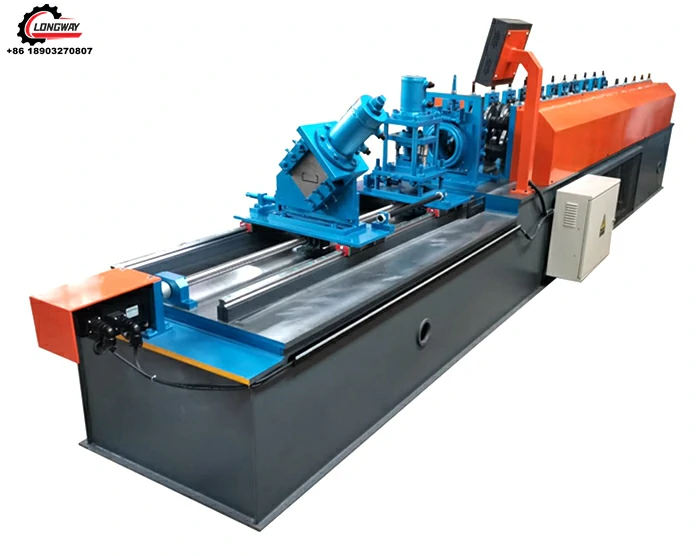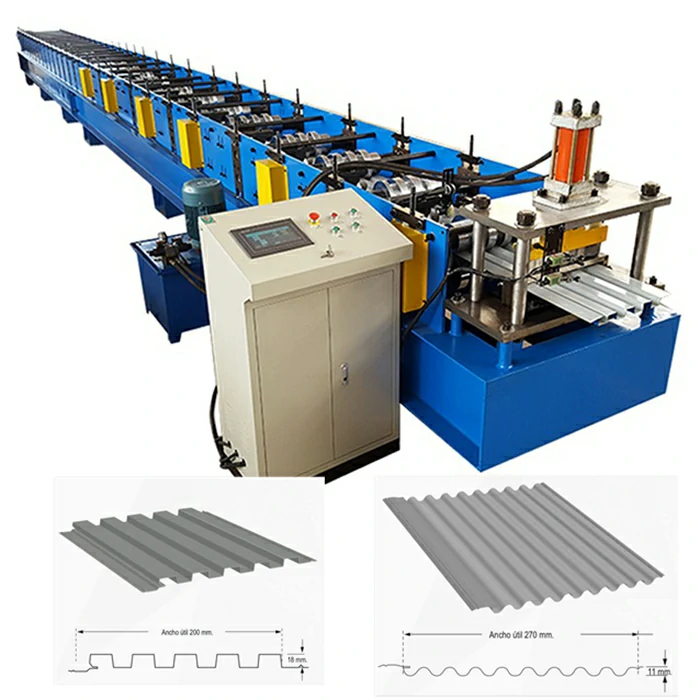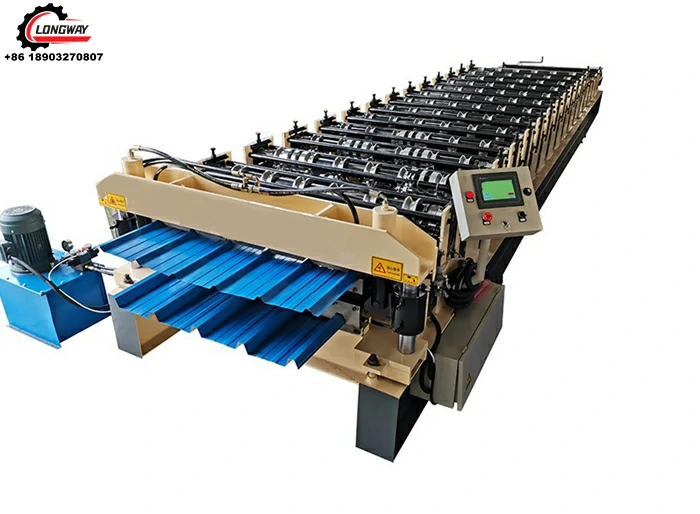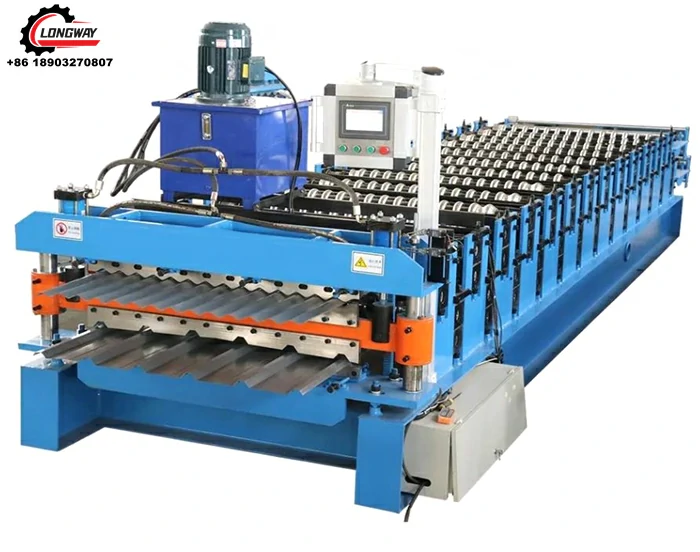Tr6 Trapezoidal Roof Panel Roll Forming Machine | Precision & Efficiency
Industry Trends in Trapezoidal Roof Panel Manufacturing
The construction sector, particularly industrial and commercial building, is undergoing significant evolution, driven by demands for increased efficiency, material optimization, and sustainable practices. Trapezoidal roof panels are a cornerstone of modern construction due to their excellent load-bearing capabilities, ease of installation, and cost-effectiveness. Key industry trends include a growing emphasis on high-strength, lightweight materials like pre-painted galvanized iron (PPGI), aluminum, and galvalume steel, requiring robust and versatile roll forming solutions. Furthermore, there's a push towards greater automation and precision in manufacturing processes to reduce labor costs and improve product consistency.
Advanced computational design and simulation tools are increasingly being integrated into machine design, enabling manufacturers to produce profiles with tighter tolerances and complex geometries. The market also observes a rising demand for machinery capable of handling diverse material thicknesses and widths, accommodating bespoke architectural requirements. Sustainability aspects, such as energy efficiency during operation and reduced material waste, are becoming critical purchasing criteria for B2B clients, driving innovation in roll forming technology. This necessitates machines like the Tr6 Trapezoidal Roof Panel Roll Forming Machine to offer not just speed and accuracy, but also adaptability and reliability to meet these evolving market dynamics.
Detailed Process Flow of the Tr6 Trapezoidal Roof Panel Roll Forming Machine
The manufacturing of trapezoidal roof panels using a Tr6 Trapezoidal Roof Panel Roll Forming Machine involves a meticulously engineered sequence of operations designed for high precision and efficiency. Understanding this process flow is crucial for optimizing production and ensuring product quality.
1. Coil Loading and Decoiling
The process begins with loading a steel coil onto the decoiler. The coils typically comprise pre-painted galvanized iron (PPGI), galvalume, or aluminum alloys, chosen for their corrosion resistance and strength. The decoiler system ensures controlled unwinding of the coil, feeding the material smoothly into the machine. Modern decoilers feature hydraulic expansion and braking systems to maintain constant tension, preventing material deformation or snags.
2. Guiding and Leveling
Upon exiting the decoiler, the metal strip passes through a guiding unit, which aligns it precisely for subsequent forming stages. This stage is critical for preventing misfeeds and ensuring consistent panel width. Following guiding, a leveling system (often a multi-roll straightener) removes any coil set or inherent curvature from the material, ensuring a flat input for the roll forming section. This is vital for maintaining geometric accuracy of the final product.
3. Roll Forming Stages
This is the core of the Tr6 Trapezoidal Roof Panel Roll Forming Machine. The flat strip is progressively shaped by a series of precisely designed roller dies. Each set of rollers incrementally bends the metal to achieve the desired trapezoidal profile. The rollers are typically manufactured from high-grade tool steel (e.g., Cr12Mov or GCr15), hardened to HRC58-62 for exceptional wear resistance, ensuring a long service life and consistent profile accuracy. The shafts are often made from 45# steel, ground and polished. The forming process involves multiple passes, typically 12-18 stations, to gradually form the shape without stressing or damaging the material's coating. Precision CNC machining is employed in the manufacturing of these rollers to ensure profile accuracy within ±0.5mm.
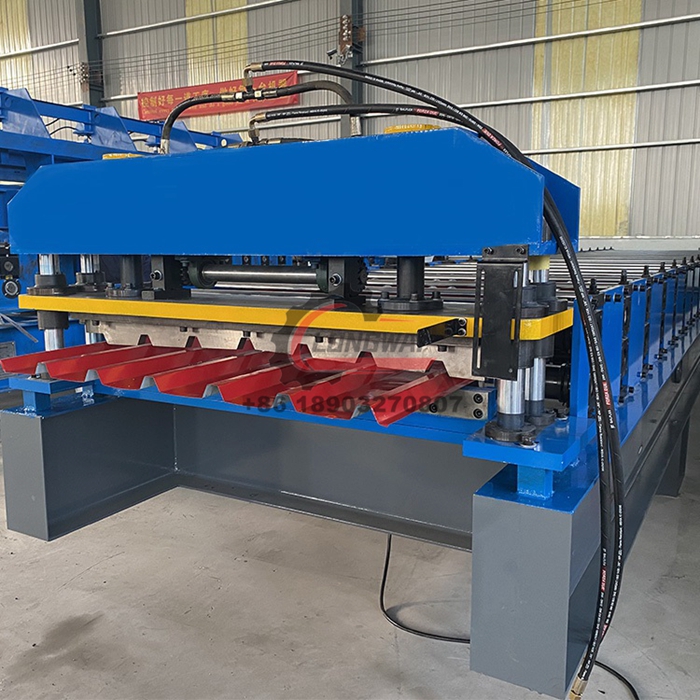
4. Cutting and Shearing
Once the panel profile is fully formed, it moves to the cutting station. Depending on the machine configuration, this can be a hydraulic post-cut shear or a flying saw. Hydraulic post-cut shears are common for their clean cuts and efficiency, while flying saws are ideal for high-speed production lines, cutting the panel to the specified length while it is still in motion, minimizing production downtime. The cutting blades are typically made from Cr12 steel with quenching treatment, ensuring durability and precise cuts.
5. Run-out Table and Stacking
After cutting, the finished panels are transferred to a run-out table. This table supports the panels as they exit the machine and can be equipped with pneumatic stackers or automated stacking systems to organize the finished panels for packaging and transport. The entire process is controlled by a PLC system (e.g., Siemens, Panasonic, Mitsubishi), ensuring synchronization of all components and allowing for easy adjustment of production parameters.
Product Materials and Manufacturing Processes:
- Main Frame: High-strength structural steel (e.g., H-beam steel), welded and stress-relieved to ensure rigidity and long-term stability.
- Rollers: Forged from GCr15 or Cr12Mov steel, CNC machined, heat-treated to HRC58-62, and hard chrome plated for superior wear resistance.
- Shafts: Precision-machined from 45# high-carbon steel, ground, and polished to minimize runout.
- Hydraulic System: Industrial-grade components from reputable manufacturers, designed for continuous operation and precise control.
Testing Standards and Service Life:
All components and the assembled Tr6 Trapezoidal Roof Panel Roll Forming Machine undergo rigorous testing to meet international standards. This includes adherence to ISO 9001 for quality management, CE certification for European market conformity, and internal QA/QC protocols for dimensional accuracy, functional performance, and safety. Critical components are tested for material composition, hardness, and surface finish. With proper maintenance and operation, the expected service life for a well-built Tr6 Trapezoidal Roof Panel Roll Forming Machine typically exceeds 15-20 years, with rollers often lasting 5-10 years before requiring regrinding or replacement, depending on material throughput and hardness.
Target Industries and Application Advantages:
This roll forming machine is indispensable across various heavy industries, including:
- Industrial & Commercial Building: Factories, warehouses, shopping malls, exhibition centers.
- Infrastructure Projects: Railway stations, airports, sports facilities.
- Agricultural Structures: Barns, storage facilities.
Advantages in typical scenarios include:
- Energy Saving: Optimized roller design reduces friction and power consumption during forming.
- Corrosion Resistance: Ability to process pre-coated and galvanized materials ensures final panels have excellent longevity in harsh environments.
- High Production Efficiency: Capable of producing panels at speeds up to 20-30 meters per minute.
- Consistent Quality: PLC control and robust construction minimize variations in panel geometry and length.
Technical Specifications of the Tr6 Trapezoidal Roof Panel Roll Forming Machine
Precision engineering and robust construction define the operational capabilities of the Tr6 Trapezoidal Roof Panel Roll Forming Machine. The following table details the key technical parameters that ensure its high performance and reliability, offering B2B decision-makers a clear understanding of its capacities.
| Parameter | Specification |
|---|---|
| Model Name | Tr6 Trapezoidal Roof Panel Roll Forming Machine |
| Material Thickness Range | 0.3 mm - 0.8 mm (Galvanized Steel, PPGI, Aluminum) |
| Effective Width of Panel | 760 mm - 1050 mm (Profile Dependent) |
| Feeding Width of Material | 914 mm - 1250 mm |
| Forming Speed | 15 - 25 meters/minute (adjustable) |
| Number of Forming Stations | 16 - 18 stations |
| Main Motor Power | 5.5 kW - 7.5 kW |
| Hydraulic Station Power | 3.0 kW - 4.0 kW |
| Control System | PLC (Siemens/Panasonic/Mitsubishi) with Touch Screen HMI |
| Rollers Material | GCr15 / Cr12Mov Quenched Steel, HRC58-62 Hardness |
| Shaft Diameter | Φ70 mm - Φ80 mm (Solid Steel) |
| Cutting Type | Hydraulic Post-Cut or Flying Shear |
| Length Tolerance | ±2 mm per 10 meters |
| Decoiler Type | Manual or Hydraulic (5-10 Ton capacity) |
| Machine Dimensions (L x W x H) | Approx. 8500 x 1500 x 1500 mm (excluding decoiler & run-out) |
| Weight | Approx. 7.0 - 9.0 Tons |
These specifications underscore the machine's capability to deliver high-quality trapezoidal panels consistently, making it a reliable asset for large-scale production facilities.
Application Scenarios and Technical Advantages
The versatility and robustness of the Tr6 Trapezoidal Roof Panel Roll Forming Machine make it suitable for a wide array of construction projects. Its technical advantages translate directly into operational efficiencies and enhanced product quality for our clients.
Primary Application Scenarios:
- Industrial Facilities: Manufacturing plants, large-span warehouses, workshops, and distribution centers benefit from the machine's ability to produce long, durable panels quickly, reducing construction time and costs.
- Commercial Buildings: Shopping malls, exhibition halls, sports arenas, and large retail outlets often require aesthetically pleasing and structurally sound roofing. The precise profiles produced by this machine ensure a superior finish.
- Agricultural Structures: Livestock shelters, grain storage facilities, and agricultural processing units require robust, weather-resistant roofing. The panels are ideal for protecting against environmental elements.
- Public Infrastructure: Train stations, airport terminals, and bus depots can utilize these panels for their large roofing needs, offering long-term durability and minimal maintenance.
Key Technical Advantages:
- High Precision Forming: Engineered roll tooling, produced via advanced CNC machining, ensures that the trapezoidal profile meets exact specifications with minimal material distortion, crucial for watertight seams and structural integrity.
- Robust Structural Design: The machine's main frame is constructed from heavy-duty welded structural steel, providing exceptional stability and vibration damping during high-speed operation, which extends the lifespan of components and maintains accuracy.
- Advanced PLC Control: Integrated with industry-leading PLC systems (e.g., Siemens, Mitsubishi), the machine offers intuitive human-machine interface (HMI) for precise control over production parameters, including length, speed, and batch quantity, minimizing operator error and maximizing output.
- Material Versatility: Capable of processing a wide range of materials, from thin PPGI to thicker galvanized steel and aluminum coils, without significant adjustments, providing flexibility for diverse project requirements.
- Optimized Power Efficiency: Equipped with energy-efficient motors and hydraulic systems, the machine is designed to reduce operational power consumption, contributing to lower overheads and a smaller environmental footprint.
- Long-Life Components: Critical wear parts, such as rollers and cutting blades, are made from heat-treated, high-alloy steels and undergo precision grinding, ensuring extended operational life and reduced maintenance frequency.
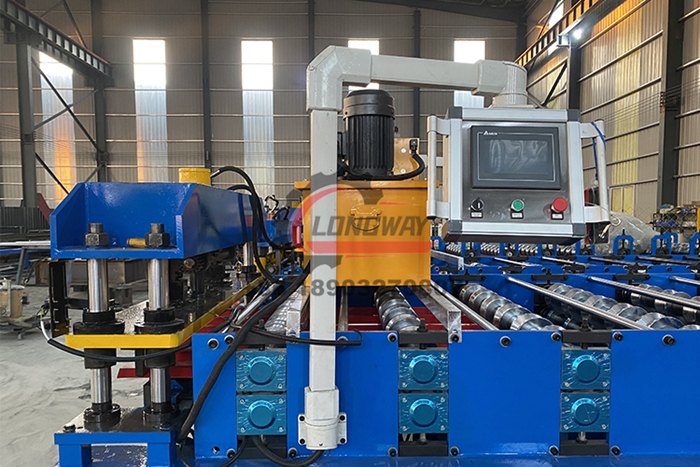
Vendor Comparison: Tr6 Trapezoidal Roll Forming Machine
Selecting the right supplier for a roll forming machine is a critical decision impacting long-term operational costs and product quality. Below is a comparative analysis of the Tr6 Trapezoidal Roof Panel Roll Forming Machine against typical market offerings, highlighting key differentiators.
| Feature/Vendor | Our Tr6 Machine | Typical Competitor A (Mid-Range) | Typical Competitor B (Budget) |
|---|---|---|---|
| Control System | Siemens/Panasonic PLC with HMI Touch Screen | Delta/Chinese Brand PLC, Basic Button Panel | Basic Relay Control, Manual Length Setting |
| Roller Material & Hardness | GCr15/Cr12Mov, HRC58-62, Hard Chrome Plated | 45# Steel, Chrome Plated, HRC45-50 | 45# Steel, Un-hardened/Lightly Treated |
| Main Frame Construction | H-beam Structural Steel, Welded, Stress-relieved | Channel Steel, Basic Welding | Angle Iron/Thin Channel Steel |
| Cutting System | Hydraulic Post-Cut (Cr12 blades) / Flying Shear option | Hydraulic Post-Cut (45# blades) | Manual or Basic Shearing |
| Max. Forming Speed | 25 m/min | 15-20 m/min | 10-12 m/min |
| Power Efficiency | Optimized design, Energy-efficient motors | Standard motors | Basic motors, higher consumption |
| Warranty & Support | 24-month comprehensive, Global support, Remote diagnostics | 12-18 month, Regional support | 6-12 month, Limited support |
This comparison highlights the superior build quality, advanced automation, and enhanced material compatibility of our Tr6 Trapezoidal Roof Panel Roll Forming Machine, translating to higher productivity, lower maintenance, and a longer operational lifespan for your investment.
Customized Solutions and Application Case Studies
Understanding that every client has unique requirements, we offer extensive customization options for the Tr6 Trapezoidal Roof Panel Roll Forming Machine. Our engineering team works closely with clients to tailor solutions that precisely meet their operational needs, from specific profile designs to integrated production line automation.
Customization Capabilities:
- Profile Design: We can design and manufacture custom roller sets for unique trapezoidal profiles, ensuring optimal aesthetics and structural performance for specialized architectural projects.
- Material Handling: Custom decoiler capacities (up to 15 tons), auto-stacking systems, and film laminators can be integrated for specific material types or higher automation needs.
- Speed and Production Volume: Machine speed can be optimized with more powerful motors and advanced control algorithms for high-volume production lines, or scaled down for more specialized, smaller batch operations.
- Integration with Existing Lines: Our machines can be designed for seamless integration into existing production infrastructures, including synchronization with upstream or downstream equipment.
- Safety and Compliance: We offer configurations compliant with specific regional safety standards (e.g., OSHA, various local electrical codes), including enhanced guarding, emergency stops, and interlocks.
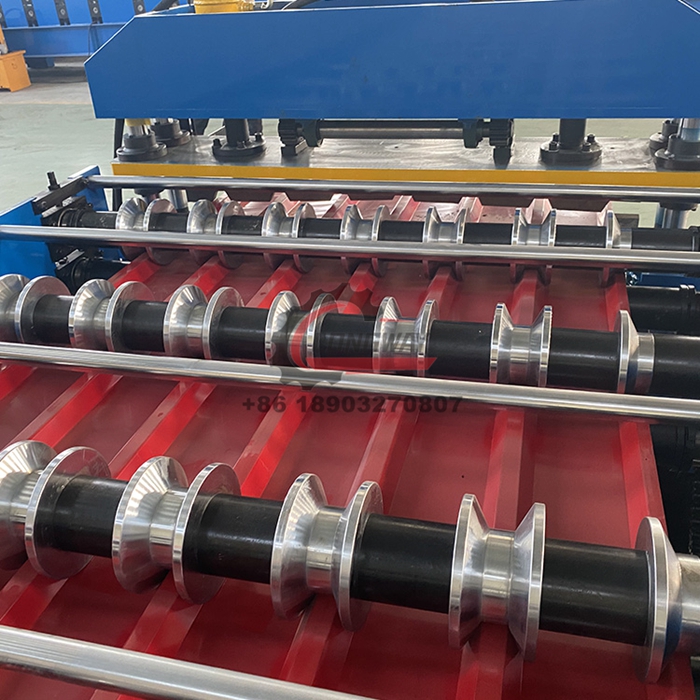
Application Case Studies:
Case Study 1: Large-Scale Industrial Park Development (Middle East)
A prominent construction firm in the Middle East required high-volume production of trapezoidal roof panels for a new industrial park spanning over 500,000 square meters. They needed a machine capable of handling various gauges of galvanized steel in a high-temperature environment. We supplied a customized Tr6 Trapezoidal Roof Panel Roll Forming Machine with an enhanced cooling system for the hydraulic unit, a 10-ton hydraulic decoiler, and an integrated auto-stacking system. The client reported a 30% increase in production efficiency compared to their previous equipment and praised the robust design for its reliability in challenging conditions. The accuracy of the panels also significantly reduced installation time on-site.
Case Study 2: Precision Panels for Architectural Landmark (Southeast Asia)
For a landmark cultural center in Southeast Asia, a specific, aesthetically driven trapezoidal roof profile was required with extremely tight tolerances and a unique color-coated aluminum material. Our team collaborated with the client's architects to develop custom roller designs. The resulting customized Tr6 Trapezoidal Roof Panel Roll Forming Machine produced panels with an effective width of 915mm from 1220mm wide, 0.7mm thick aluminum coil, achieving a length accuracy of ±1mm over 15 meters. The precision of the machine ensured a flawless appearance for the highly visible roof structure, exceeding the client's stringent quality expectations.

FAQ - Frequently Asked Questions
Here are answers to some common questions about the Tr6 Trapezoidal Roof Panel Roll Forming Machine to assist in your decision-making process.
Q1: What materials can the Tr6 machine process?
A1: Our Tr6 Trapezoidal Roof Panel Roll Forming Machine is designed to handle various metal coil materials, including pre-painted galvanized iron (PPGI), galvanized steel, galvalume, and aluminum alloys. It can typically process material thicknesses ranging from 0.3mm to 0.8mm.
Q2: What is the typical lead time for an order?
A2: Standard configurations of the Tr6 machine typically have a lead time of 45-60 working days from order confirmation and receipt of down payment. Customized solutions may require an additional 15-30 days for design, manufacturing of special tooling, and testing. Fulfillment details will be provided in a detailed project timeline.
Q3: What warranty is provided with the machine?
A3: We offer a comprehensive 24-month warranty on all mechanical and electrical components of the Tr6 Trapezoidal Roof Panel Roll Forming Machine, starting from the date of successful commissioning. Wear parts are subject to a standard 6-month warranty. Full warranty terms and conditions are provided with the purchase agreement.
Q4: What kind of after-sales support and technical assistance can I expect?
A4: We are committed to exceptional after-sales support. This includes remote diagnostics and troubleshooting, online technical guidance, and a readily available inventory of spare parts. For complex issues, on-site technical assistance can be arranged by our experienced engineers worldwide. We also provide comprehensive training for your operators and maintenance staff during installation and commissioning.
Q5: Can the machine be integrated into an existing production line?
A5: Yes, the Tr6 machine is designed with integration capabilities. Our engineering team can work with you to ensure seamless compatibility with your existing decoilers, uncoilers, stackers, or other upstream/downstream equipment, optimizing your overall production workflow.
References
- European Committee for Standardization. EN 10162: Cold rolled steel sections. Technical delivery conditions.
- International Organization for Standardization. ISO 9001:2015: Quality management systems – Requirements.
- ASM International. (2000). ASM Handbook, Volume 14A: Metalworking: Bulk Forming.
- The Fabricator. (2023). Trends in Roll Forming: Automation, Customization, and Sustainability.
-
Corrugated iron roofing sheet making machine with CE, AutoNewsNov.17, 2025
-
3mm Steel C U Channel Roll Forming Machine, Heavy DutyNewsNov.17, 2025
-
Calamima Micro Ondulada corrugated roof sheet machine - CNCNewsNov.17, 2025
-
Metal Roofing Roll Former for Sale Companies - Fast, PreciseNewsNov.17, 2025
-
Drywall Steel L Angle Bar forming machine | Fast, PreciseNewsNov.17, 2025
-
Corrugated Iron Roofing Sheet Making Machine, Fast & DurableNewsNov.11, 2025
-
Corrugated Metal Roofing Machine | High-Speed, Precise, CENewsNov.11, 2025
Tr6 Trapezoidal Roof Panel Roll Forming Machine | Precision & Efficiency
Industry Trends in Trapezoidal Roof Panel Manufacturing
The construction sector, particularly industrial and commercial building, is undergoing significant evolution, driven by demands for increased efficiency, material optimization, and sustainable practices. Trapezoidal roof panels are a cornerstone of modern construction due to their excellent load-bearing capabilities, ease of installation, and cost-effectiveness. Key industry trends include a growing emphasis on high-strength, lightweight materials like pre-painted galvanized iron (PPGI), aluminum, and galvalume steel, requiring robust and versatile roll forming solutions. Furthermore, there's a push towards greater automation and precision in manufacturing processes to reduce labor costs and improve product consistency.
Advanced computational design and simulation tools are increasingly being integrated into machine design, enabling manufacturers to produce profiles with tighter tolerances and complex geometries. The market also observes a rising demand for machinery capable of handling diverse material thicknesses and widths, accommodating bespoke architectural requirements. Sustainability aspects, such as energy efficiency during operation and reduced material waste, are becoming critical purchasing criteria for B2B clients, driving innovation in roll forming technology. This necessitates machines like the Tr6 Trapezoidal Roof Panel Roll Forming Machine to offer not just speed and accuracy, but also adaptability and reliability to meet these evolving market dynamics.
Detailed Process Flow of the Tr6 Trapezoidal Roof Panel Roll Forming Machine
The manufacturing of trapezoidal roof panels using a Tr6 Trapezoidal Roof Panel Roll Forming Machine involves a meticulously engineered sequence of operations designed for high precision and efficiency. Understanding this process flow is crucial for optimizing production and ensuring product quality.
1. Coil Loading and Decoiling
The process begins with loading a steel coil onto the decoiler. The coils typically comprise pre-painted galvanized iron (PPGI), galvalume, or aluminum alloys, chosen for their corrosion resistance and strength. The decoiler system ensures controlled unwinding of the coil, feeding the material smoothly into the machine. Modern decoilers feature hydraulic expansion and braking systems to maintain constant tension, preventing material deformation or snags.
2. Guiding and Leveling
Upon exiting the decoiler, the metal strip passes through a guiding unit, which aligns it precisely for subsequent forming stages. This stage is critical for preventing misfeeds and ensuring consistent panel width. Following guiding, a leveling system (often a multi-roll straightener) removes any coil set or inherent curvature from the material, ensuring a flat input for the roll forming section. This is vital for maintaining geometric accuracy of the final product.
3. Roll Forming Stages
This is the core of the Tr6 Trapezoidal Roof Panel Roll Forming Machine. The flat strip is progressively shaped by a series of precisely designed roller dies. Each set of rollers incrementally bends the metal to achieve the desired trapezoidal profile. The rollers are typically manufactured from high-grade tool steel (e.g., Cr12Mov or GCr15), hardened to HRC58-62 for exceptional wear resistance, ensuring a long service life and consistent profile accuracy. The shafts are often made from 45# steel, ground and polished. The forming process involves multiple passes, typically 12-18 stations, to gradually form the shape without stressing or damaging the material's coating. Precision CNC machining is employed in the manufacturing of these rollers to ensure profile accuracy within ±0.5mm.

4. Cutting and Shearing
Once the panel profile is fully formed, it moves to the cutting station. Depending on the machine configuration, this can be a hydraulic post-cut shear or a flying saw. Hydraulic post-cut shears are common for their clean cuts and efficiency, while flying saws are ideal for high-speed production lines, cutting the panel to the specified length while it is still in motion, minimizing production downtime. The cutting blades are typically made from Cr12 steel with quenching treatment, ensuring durability and precise cuts.
5. Run-out Table and Stacking
After cutting, the finished panels are transferred to a run-out table. This table supports the panels as they exit the machine and can be equipped with pneumatic stackers or automated stacking systems to organize the finished panels for packaging and transport. The entire process is controlled by a PLC system (e.g., Siemens, Panasonic, Mitsubishi), ensuring synchronization of all components and allowing for easy adjustment of production parameters.
Product Materials and Manufacturing Processes:
- Main Frame: High-strength structural steel (e.g., H-beam steel), welded and stress-relieved to ensure rigidity and long-term stability.
- Rollers: Forged from GCr15 or Cr12Mov steel, CNC machined, heat-treated to HRC58-62, and hard chrome plated for superior wear resistance.
- Shafts: Precision-machined from 45# high-carbon steel, ground, and polished to minimize runout.
- Hydraulic System: Industrial-grade components from reputable manufacturers, designed for continuous operation and precise control.
Testing Standards and Service Life:
All components and the assembled Tr6 Trapezoidal Roof Panel Roll Forming Machine undergo rigorous testing to meet international standards. This includes adherence to ISO 9001 for quality management, CE certification for European market conformity, and internal QA/QC protocols for dimensional accuracy, functional performance, and safety. Critical components are tested for material composition, hardness, and surface finish. With proper maintenance and operation, the expected service life for a well-built Tr6 Trapezoidal Roof Panel Roll Forming Machine typically exceeds 15-20 years, with rollers often lasting 5-10 years before requiring regrinding or replacement, depending on material throughput and hardness.
Target Industries and Application Advantages:
This roll forming machine is indispensable across various heavy industries, including:
- Industrial & Commercial Building: Factories, warehouses, shopping malls, exhibition centers.
- Infrastructure Projects: Railway stations, airports, sports facilities.
- Agricultural Structures: Barns, storage facilities.
Advantages in typical scenarios include:
- Energy Saving: Optimized roller design reduces friction and power consumption during forming.
- Corrosion Resistance: Ability to process pre-coated and galvanized materials ensures final panels have excellent longevity in harsh environments.
- High Production Efficiency: Capable of producing panels at speeds up to 20-30 meters per minute.
- Consistent Quality: PLC control and robust construction minimize variations in panel geometry and length.
Technical Specifications of the Tr6 Trapezoidal Roof Panel Roll Forming Machine
Precision engineering and robust construction define the operational capabilities of the Tr6 Trapezoidal Roof Panel Roll Forming Machine. The following table details the key technical parameters that ensure its high performance and reliability, offering B2B decision-makers a clear understanding of its capacities.
| Parameter | Specification |
|---|---|
| Model Name | Tr6 Trapezoidal Roof Panel Roll Forming Machine |
| Material Thickness Range | 0.3 mm - 0.8 mm (Galvanized Steel, PPGI, Aluminum) |
| Effective Width of Panel | 760 mm - 1050 mm (Profile Dependent) |
| Feeding Width of Material | 914 mm - 1250 mm |
| Forming Speed | 15 - 25 meters/minute (adjustable) |
| Number of Forming Stations | 16 - 18 stations |
| Main Motor Power | 5.5 kW - 7.5 kW |
| Hydraulic Station Power | 3.0 kW - 4.0 kW |
| Control System | PLC (Siemens/Panasonic/Mitsubishi) with Touch Screen HMI |
| Rollers Material | GCr15 / Cr12Mov Quenched Steel, HRC58-62 Hardness |
| Shaft Diameter | Φ70 mm - Φ80 mm (Solid Steel) |
| Cutting Type | Hydraulic Post-Cut or Flying Shear |
| Length Tolerance | ±2 mm per 10 meters |
| Decoiler Type | Manual or Hydraulic (5-10 Ton capacity) |
| Machine Dimensions (L x W x H) | Approx. 8500 x 1500 x 1500 mm (excluding decoiler & run-out) |
| Weight | Approx. 7.0 - 9.0 Tons |
These specifications underscore the machine's capability to deliver high-quality trapezoidal panels consistently, making it a reliable asset for large-scale production facilities.
Application Scenarios and Technical Advantages
The versatility and robustness of the Tr6 Trapezoidal Roof Panel Roll Forming Machine make it suitable for a wide array of construction projects. Its technical advantages translate directly into operational efficiencies and enhanced product quality for our clients.
Primary Application Scenarios:
- Industrial Facilities: Manufacturing plants, large-span warehouses, workshops, and distribution centers benefit from the machine's ability to produce long, durable panels quickly, reducing construction time and costs.
- Commercial Buildings: Shopping malls, exhibition halls, sports arenas, and large retail outlets often require aesthetically pleasing and structurally sound roofing. The precise profiles produced by this machine ensure a superior finish.
- Agricultural Structures: Livestock shelters, grain storage facilities, and agricultural processing units require robust, weather-resistant roofing. The panels are ideal for protecting against environmental elements.
- Public Infrastructure: Train stations, airport terminals, and bus depots can utilize these panels for their large roofing needs, offering long-term durability and minimal maintenance.
Key Technical Advantages:
- High Precision Forming: Engineered roll tooling, produced via advanced CNC machining, ensures that the trapezoidal profile meets exact specifications with minimal material distortion, crucial for watertight seams and structural integrity.
- Robust Structural Design: The machine's main frame is constructed from heavy-duty welded structural steel, providing exceptional stability and vibration damping during high-speed operation, which extends the lifespan of components and maintains accuracy.
- Advanced PLC Control: Integrated with industry-leading PLC systems (e.g., Siemens, Mitsubishi), the machine offers intuitive human-machine interface (HMI) for precise control over production parameters, including length, speed, and batch quantity, minimizing operator error and maximizing output.
- Material Versatility: Capable of processing a wide range of materials, from thin PPGI to thicker galvanized steel and aluminum coils, without significant adjustments, providing flexibility for diverse project requirements.
- Optimized Power Efficiency: Equipped with energy-efficient motors and hydraulic systems, the machine is designed to reduce operational power consumption, contributing to lower overheads and a smaller environmental footprint.
- Long-Life Components: Critical wear parts, such as rollers and cutting blades, are made from heat-treated, high-alloy steels and undergo precision grinding, ensuring extended operational life and reduced maintenance frequency.

Vendor Comparison: Tr6 Trapezoidal Roll Forming Machine
Selecting the right supplier for a roll forming machine is a critical decision impacting long-term operational costs and product quality. Below is a comparative analysis of the Tr6 Trapezoidal Roof Panel Roll Forming Machine against typical market offerings, highlighting key differentiators.
| Feature/Vendor | Our Tr6 Machine | Typical Competitor A (Mid-Range) | Typical Competitor B (Budget) |
|---|---|---|---|
| Control System | Siemens/Panasonic PLC with HMI Touch Screen | Delta/Chinese Brand PLC, Basic Button Panel | Basic Relay Control, Manual Length Setting |
| Roller Material & Hardness | GCr15/Cr12Mov, HRC58-62, Hard Chrome Plated | 45# Steel, Chrome Plated, HRC45-50 | 45# Steel, Un-hardened/Lightly Treated |
| Main Frame Construction | H-beam Structural Steel, Welded, Stress-relieved | Channel Steel, Basic Welding | Angle Iron/Thin Channel Steel |
| Cutting System | Hydraulic Post-Cut (Cr12 blades) / Flying Shear option | Hydraulic Post-Cut (45# blades) | Manual or Basic Shearing |
| Max. Forming Speed | 25 m/min | 15-20 m/min | 10-12 m/min |
| Power Efficiency | Optimized design, Energy-efficient motors | Standard motors | Basic motors, higher consumption |
| Warranty & Support | 24-month comprehensive, Global support, Remote diagnostics | 12-18 month, Regional support | 6-12 month, Limited support |
This comparison highlights the superior build quality, advanced automation, and enhanced material compatibility of our Tr6 Trapezoidal Roof Panel Roll Forming Machine, translating to higher productivity, lower maintenance, and a longer operational lifespan for your investment.
Customized Solutions and Application Case Studies
Understanding that every client has unique requirements, we offer extensive customization options for the Tr6 Trapezoidal Roof Panel Roll Forming Machine. Our engineering team works closely with clients to tailor solutions that precisely meet their operational needs, from specific profile designs to integrated production line automation.
Customization Capabilities:
- Profile Design: We can design and manufacture custom roller sets for unique trapezoidal profiles, ensuring optimal aesthetics and structural performance for specialized architectural projects.
- Material Handling: Custom decoiler capacities (up to 15 tons), auto-stacking systems, and film laminators can be integrated for specific material types or higher automation needs.
- Speed and Production Volume: Machine speed can be optimized with more powerful motors and advanced control algorithms for high-volume production lines, or scaled down for more specialized, smaller batch operations.
- Integration with Existing Lines: Our machines can be designed for seamless integration into existing production infrastructures, including synchronization with upstream or downstream equipment.
- Safety and Compliance: We offer configurations compliant with specific regional safety standards (e.g., OSHA, various local electrical codes), including enhanced guarding, emergency stops, and interlocks.

Application Case Studies:
Case Study 1: Large-Scale Industrial Park Development (Middle East)
A prominent construction firm in the Middle East required high-volume production of trapezoidal roof panels for a new industrial park spanning over 500,000 square meters. They needed a machine capable of handling various gauges of galvanized steel in a high-temperature environment. We supplied a customized Tr6 Trapezoidal Roof Panel Roll Forming Machine with an enhanced cooling system for the hydraulic unit, a 10-ton hydraulic decoiler, and an integrated auto-stacking system. The client reported a 30% increase in production efficiency compared to their previous equipment and praised the robust design for its reliability in challenging conditions. The accuracy of the panels also significantly reduced installation time on-site.
Case Study 2: Precision Panels for Architectural Landmark (Southeast Asia)
For a landmark cultural center in Southeast Asia, a specific, aesthetically driven trapezoidal roof profile was required with extremely tight tolerances and a unique color-coated aluminum material. Our team collaborated with the client's architects to develop custom roller designs. The resulting customized Tr6 Trapezoidal Roof Panel Roll Forming Machine produced panels with an effective width of 915mm from 1220mm wide, 0.7mm thick aluminum coil, achieving a length accuracy of ±1mm over 15 meters. The precision of the machine ensured a flawless appearance for the highly visible roof structure, exceeding the client's stringent quality expectations.

FAQ - Frequently Asked Questions
Here are answers to some common questions about the Tr6 Trapezoidal Roof Panel Roll Forming Machine to assist in your decision-making process.
Q1: What materials can the Tr6 machine process?
A1: Our Tr6 Trapezoidal Roof Panel Roll Forming Machine is designed to handle various metal coil materials, including pre-painted galvanized iron (PPGI), galvanized steel, galvalume, and aluminum alloys. It can typically process material thicknesses ranging from 0.3mm to 0.8mm.
Q2: What is the typical lead time for an order?
A2: Standard configurations of the Tr6 machine typically have a lead time of 45-60 working days from order confirmation and receipt of down payment. Customized solutions may require an additional 15-30 days for design, manufacturing of special tooling, and testing. Fulfillment details will be provided in a detailed project timeline.
Q3: What warranty is provided with the machine?
A3: We offer a comprehensive 24-month warranty on all mechanical and electrical components of the Tr6 Trapezoidal Roof Panel Roll Forming Machine, starting from the date of successful commissioning. Wear parts are subject to a standard 6-month warranty. Full warranty terms and conditions are provided with the purchase agreement.
Q4: What kind of after-sales support and technical assistance can I expect?
A4: We are committed to exceptional after-sales support. This includes remote diagnostics and troubleshooting, online technical guidance, and a readily available inventory of spare parts. For complex issues, on-site technical assistance can be arranged by our experienced engineers worldwide. We also provide comprehensive training for your operators and maintenance staff during installation and commissioning.
Q5: Can the machine be integrated into an existing production line?
A5: Yes, the Tr6 machine is designed with integration capabilities. Our engineering team can work with you to ensure seamless compatibility with your existing decoilers, uncoilers, stackers, or other upstream/downstream equipment, optimizing your overall production workflow.
References
- European Committee for Standardization. EN 10162: Cold rolled steel sections. Technical delivery conditions.
- International Organization for Standardization. ISO 9001:2015: Quality management systems – Requirements.
- ASM International. (2000). ASM Handbook, Volume 14A: Metalworking: Bulk Forming.
- The Fabricator. (2023). Trends in Roll Forming: Automation, Customization, and Sustainability.
-
Corrugated iron roofing sheet making machine with CE, AutoNewsNov.17, 2025
-
3mm Steel C U Channel Roll Forming Machine, Heavy DutyNewsNov.17, 2025
-
Calamima Micro Ondulada corrugated roof sheet machine - CNCNewsNov.17, 2025
-
Metal Roofing Roll Former for Sale Companies - Fast, PreciseNewsNov.17, 2025
-
Drywall Steel L Angle Bar forming machine | Fast, PreciseNewsNov.17, 2025
-
Corrugated Iron Roofing Sheet Making Machine, Fast & DurableNewsNov.11, 2025
-
Corrugated Metal Roofing Machine | High-Speed, Precise, CENewsNov.11, 2025
